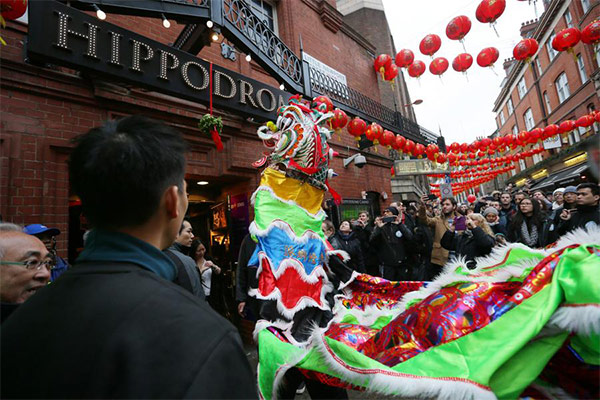
People watch lion dance in Chinatown during the celebration for the Chinese Lunar New Year in London, Britain, on Jan 29, 2017. [Photo/Xinhua]
Spring Festival, celebrated across China as the nation’s biggest annual holiday, is being embraced by more countries as an occasion to participate in Chinese festivities and as a unique way to experience Chinese culture in general.
On January 5, Pakistani students of Chinese cuisine prepared laba porridge and jiaozi with their Chinese teachers, and a series of exhibitions including Chinese animation films and Chinese children’s books were unveiled in Singapore-kicking off a massive official program known as “Happy Chinese New Year”. One month later, the program is still going strong around the world.
The 2,000-event program, organized by the Ministry of Culture, covers about 400 cities in 130 countries. In Africa alone, Chinese performing arts troupes have been traveling along six routes to cover as wide an area as possible.
While this year’s data is not yet available, as a reference point last year’s festivities drew 250 million participants overseas, including 1,000 official dignitaries.
Although the Chinese diaspora have always taken their homegrown habits and holidays to their new lands of settlement, “Happy Chinese New Year” is an officially sponsored, concerted effort to share this Chinese holiday with the rest of the world. Now in its eighth year, the program has branched into many categories of performing and visual arts.
Overseas exhibitions of Chinese art and tours of Chinese artists around the Lunar New Year holiday were already underway, going back to at least 2001, before everything fell under the umbrella of “Happy Chinese New Year”. However, better coordination has been achieved with the master program, with resources pooled from a rich diversity of sources and a goal of attaining balance between trade and cultural exchanges.
This year’s fetes featured a multifaceted display of Chinese arts, from the folksy, such as traditional paper cuttings in Brussels, to the high-brow, such as the North America tour of the Beijing Symphony Orchestra. The orchestra’s program features unique pieces including France-based Chinese composer Chen Qigang’s L’eloingement, which translates as “Go to the West” and tells the story of Chinese emigrants to Western countries.
The highlights of this year’s program are traditional Chinese music and intangible cultural relics. An event on Jan 29 in Stockholm’s Chinese Cultural Center was a case in point: It featured Chinese puppetry, traditional musical instruments and painted clay figurines from Shandong province that visitors could hold in their hands.
Not only can curious foreign visitors find Chinese exhibitions in venues such as museums, but they can have a firsthand encounter with the charm of Chinese culture in its most diversified and animated forms.
Li Jiangang, deputy director of the Foreign Exchange Bureau of the Ministry of Culture, said about 10 countries including Canada, Malaysia, Singapore and Mauritius have made Chinese Lunar New Year a legal holiday.
Li said that different parts of the program will be customized for different countries or regions, with the overall purpose of integrating the festivities with local culture and turning them into part of a larger appreciation and understanding of Chinese culture.
